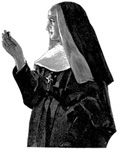
St. Monica: Mother, Wife & Homemaker as Saint
THE QUINTESSENCE OF WOMANHOOD
A person can measure his happiness and success in terms of public acclaim and recognized achievements or in terms of personal enrichment and humble deeds. A person can measure his life in terms of quantifiable results such as income, honors, victories, or publications or in terms of intangible criteria such as the love one brings to others or the lives one touches. A person can judge the quality of his life according to worldly standards or according to the ideals of the saints. A person can live in the limelight and on a grand scale or follow St. Thérèse of Lisieux’s “little way” of obscurity and self-forgetfulness.
A person can live in simplicity and do one thing well or live in multiplicity and do many things poorly. A person can live in a state of grace and bring peace and gladness to others or live out of grace and become a burden to everyone.
The character and life of Monica epitomize an ideal of sainthood essential for a modern world suffering a crisis of the family and the deconstruction of the home.
In Confessions, St. Augustine presents the lives of three saints. While narrating the story of his conversion from Manichaeism to Christianity, Augustine not only remembers the profound influence of St. Ambrose’s holy example and moving eloquence but also records the sanctity of his mother’s life. While Augustine and Ambrose assumed public positions of prominence as eminent teachers and great Church fathers, Monica lived her entire life in the domestic realm as an obedient daughter, dutiful wife, loving mother, and kind friend. While Augustine and Ambrose earned the title of bishop and addressed multitudes through their gifts of writing and speaking, Monica’s sphere of influence was modest and humble. She waged no intellectual wars with the Manichaeans and never wrote on the doctrine of the Trinity. But Monica’s stature is as great as the reputations of the golden-tongued Bishop of Milan and the intellectually gifted Bishop of Hippo. What is the secret of her sainthood?
You May Also Enjoy
Within the Reformed tradition, the most famous articulation of perspicuity, or clarity, is found in the 17th-century Westminster Confession of Faith.
The ever-living and developing Church directly connected to Christ through the Tradition of the Fathers is the only hope out of the dark forest of individual opinion.
Here is a conversion story that talks about how you join the Church seeking a kind of haven and then all hell breaks loose.

